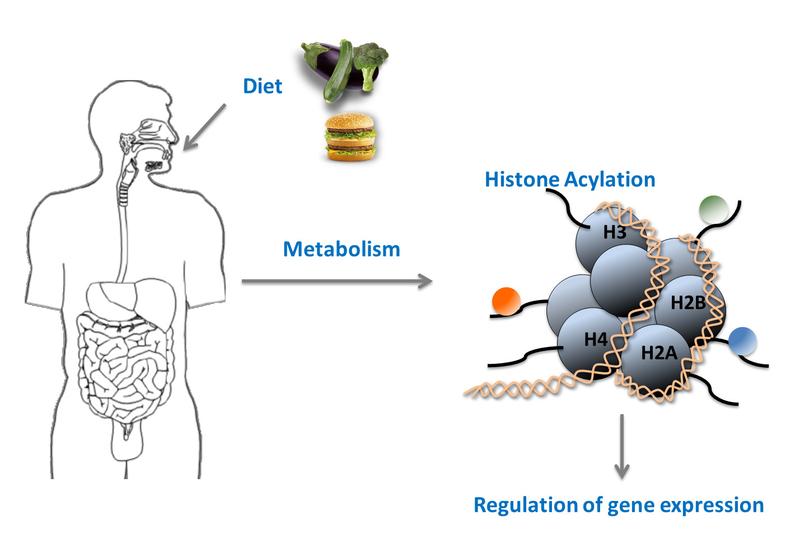

Two new classes of histone modifications couple diet and cellular metabolism to gene activity.
Source: Helmholtz Zentrum München
DNA is wrapped around proteins called histones, which serve to package the DNA inside the cell nucleus and play an important role in regulating gene expression. Histone proteins can be modified with small chemical groups, many of which are products of cellular metabolism. By impairing or enhancing transcription, these modifications are able to influence gene activity.
While this could provide a potential mechanism through which our environment – for example the food we eat – can lead to changes in gene expression, it remains unclear how histone marks are really coupled to cellular metabolism and how this might affect chromatin organisation* and gene activity.
In this study, Robert Schneider’s team from the Institute of Functional Epigenetics (IFE) at Helmholtz Zentrum München and LMU looked at two novel modifications, propionylation and butyrylation (i.e. the addition of propionyl and butyryl groups to the histone proteins). The researchers found that propionyl and butyryl groups can be present on histone H3, specifically at lysine residue 14 (H3K14).
Propionate and butyrate are products of fatty acid metabolism
According to the study, these modifications specifically mark highly expressed genes and their presence changes upon metabolic alterations, for example upon fasting. The researchers also showed that histone propionylation can drive transcription in the test tube (in vitro) suggesting it is a stimulatory mark capable of causing genes to be expressed when it is present.
“Interestingly, propionate and butyrate are products of fatty acid metabolism” explains Robert Schneider. “This means that these histone modifications might be a way through which the metabolic state of the cell is linked to chromatin architecture.”
One way in which histone modifications elicit biological responses is by being recognised by specific proteins, so-called “readers”. Using a combination of pulldown assays and mass spectrometry, the team identified the specific reader proteins for these novel marks. The addition of these marks in response to fatty acid metabolism and binding of the reader proteins changes the signature of chromatin and thus it’s functional state. “These results are especially significant with regard to metabolic diseases, like diabetes and obesity” said Schneider. “Our aim now is to study the role of these new gene switches in disease models.”
The results suggest a possible role for histone propionylation in metabolic signalling and disease as propionyl-CoA carboxylase (the enzyme that degrades this co-factor) is implicated in metabolic diseases and indeed alters histone propionylation.
Further Information
* The term chromatin refers to a complex consisting of DNA, protein, and RNA. The primary functions of chromatin are to package DNA into a more compact, denser shape, to reinforce the DNA macromolecule.
Background:
This study was resulting from collaborations with the IGBMC in Strasbourg and with Maria Colomé-Tatché from the Institute of Computational Biology at Helmholtz Zentrum München. It is the first functional characterisation of the novel histone acylations H3K14pr and H3K14bu and their direct link to fatty acid metabolism.
The co-authors Anna Nieborak and Lara Zorro Shahidian are participants of the Helmholtz Graduate School for Environmental Health (HELENA).
Original Publication:
Kebede, AF. et al. (2017): Histone propionylation is a novel mark of active chromatin. Nature Structural and Molecular Biology, DOI: 10.1038/nsmb.3490
As German Research Center for Environmental Health, Helmholtz Zentrum München pursues the goal of developing personalized medical approaches for the prevention and therapy of major common diseases such as diabetes mellitus and lung diseases. To achieve this, it investigates the interaction of genetics, environmental factors and lifestyle. The Helmholtz Zentrum München has about 2,300 staff members and is headquartered in Neuherberg in the north of Munich. Helmholtz Zentrum München is a member of the Helmholtz Association, a community of 18 scientific-technical and medical-biological research centers with a total of about 37,000 staff members. http://www.helmholtz-muenchen.de/en
The Institute of Functional Epigenetics (IFE) is interested in how genes are packaged within the nucleus of a cell. The focus is on the so-called “histone proteins” on which the DNA strands are wound and that can determine whether a gene can be read or not. In addition, we are examining the connections between common diseases and distortions in DNA packing. We utilize cutting edge methods that enable us to follow changes of these processes even in individual cells. http://www.helmholtz-muenchen.de/ife/index.html
As one of Europe's leading research universities, LMU Munich is committed to the highest international standards of excellence in research and teaching. Building on its 500-year-tradition of scholarship, LMU covers a broad spectrum of disciplines, ranging from the humanities and cultural studies through law, economics and social studies to medicine and the sciences. 15 percent of LMU‘s 50,000 students come from abroad, originating from 130 countries worldwide. The know-how and creativity of LMU's academics form the foundation of the University's outstanding research record. This is also reflected in LMU‘s designation of as a “university of excellence” in the context of the Excellence Initiative, a nationwide competition to promote top-level university research. http://www.en.uni-muenchen.de/index.html
Contact for the media:
Department of Communication, Helmholtz Zentrum München – German Research Center for Environmental Health, Ingolstädter Landstr. 1, 85764 Neuherberg – Tel. +49 89 3187 2238 – E-mail: presse@helmholtz-muenchen.de
Scientific Contact at Helmholtz Zentrum München:
Prof. Dr. Robert Schneider, Helmholtz Zentrum München – German Research Center for Environmental Health, Institute of Functional Epigenetics, Ingolstädter Landstr. 1, 85764 Neuherberg – Tel. +49 89 3187 3569, E-mail: robert.schneider@helmholtz-muenchen.de












